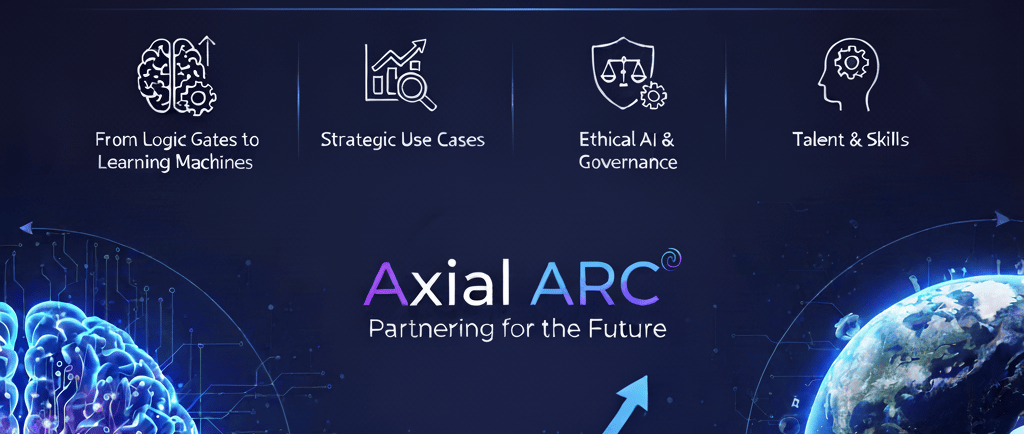Navigating the AI Frontier: A CIO's Guide to Intelligent Evolution
Bryon Spahn
9/29/20254 min read


Artificial Intelligence (AI) is no longer a futuristic concept confined to sci-fi thrillers. It's a transformative force reshaping industries, redefining competitive landscapes, and presenting both unprecedented opportunities and profound challenges for technology leaders. As CIOs and technology executives, understanding AI's journey, its current trajectory, and its potential future is paramount to crafting resilient and forward-thinking technology strategies.
From Logic Gates to Learning Machines: A Brief History of AI
The seeds of AI were sown in the mid-20th century with pioneers like Alan Turing envisioning "thinking machines." Early AI, often referred to as "Good Old-Fashioned AI" (GOFAI), relied heavily on symbolic logic, rule-based systems, and expert systems. These early attempts, while foundational, were limited by their inability to learn from data or adapt to unforeseen circumstances.
The 21st century has witnessed an explosion in AI capabilities, largely driven by advances in:
Machine Learning (ML): This subfield of AI allows systems to learn from data without explicit programming. Techniques like supervised, unsupervised, and reinforcement learning have become cornerstones of modern AI applications.
Deep Learning (DL): A specialized form of ML, deep learning utilizes artificial neural networks with multiple layers to process complex data patterns. This breakthrough has fueled the remarkable progress in areas like image recognition, natural language processing, and autonomous systems.
Big Data: The proliferation of digital data provides the fuel for these learning algorithms, enabling them to identify intricate patterns and make more accurate predictions.
Computational Power: The exponential increase in computing power, particularly with the advent of GPUs, has made it feasible to train and deploy complex AI models.
Today, AI manifests in numerous forms:
Natural Language Processing (NLP): Powering chatbots, translation services, and sentiment analysis tools.
Computer Vision: Enabling facial recognition, autonomous vehicles, and medical image analysis.
Predictive Analytics: Driving personalized recommendations, fraud detection, and optimized supply chains.
Robotics: From industrial automation to collaborative robots working alongside humans.
AI Today: Strategic Imperatives for Technology Leaders
For CIOs, the immediate challenge is to move beyond AI hype and strategically integrate it into their organizations. This involves:
Identifying High-Impact Use Cases: Don't chase every AI trend. Focus on areas where AI can deliver tangible business value, such as enhancing customer experience, optimizing operational efficiency, or developing new products and services.
Building a Robust Data Strategy: AI is only as good as the data it's trained on. Invest in data governance, quality, and accessibility to ensure your AI initiatives are built on a solid foundation.
Investing in Talent and Skills: The demand for AI specialists, data scientists, and ML engineers far outstrips supply. Develop internal training programs, foster a culture of continuous learning, and consider strategic partnerships to bridge skill gaps.
Addressing Ethical AI and Governance: As AI becomes more pervasive, ethical considerations around bias, fairness, transparency, and accountability are critical. Establish clear AI governance frameworks and ethical guidelines from the outset.
Cultivating an AI-Ready Culture: Successful AI adoption requires more than just technology; it demands a cultural shift. Encourage experimentation, cross-functional collaboration, and a willingness to embrace new ways of working.
The Superintelligence Horizon: What CIOs Need to Know
While current AI excels at specific tasks, a more profound transformation lies on the horizon: Artificial General Intelligence (AGI) and ultimately, AI Superintelligence.
Artificial General Intelligence (AGI): This refers to AI that can understand, learn, and apply intelligence across a broad range of tasks, similar to human cognitive abilities. We are not there yet, but research continues to push these boundaries.
AI Superintelligence: This hypothetical future state describes AI that far surpasses human intelligence across virtually all cognitive domains. If achieved, this milestone would represent a fundamental shift in human history and organizational dynamics.
What might AI Superintelligence mean for organizations?
Unprecedented Problem Solving: Superintelligent AI could tackle complex global challenges in science, medicine, and engineering with unparalleled efficiency and insight.
Automated Innovation: The pace of innovation could accelerate dramatically, with AI designing new technologies, optimizing processes, and even discovering new scientific principles.
Redefining Work and Value Creation: Many roles, particularly those involving routine cognitive tasks, could be fully automated. Organizations would need to profoundly rethink workforce strategies, focusing on uniquely human skills and the collaborative potential with superintelligent systems.
Strategic Imperative of Alignment: The ability to align the goals and values of a superintelligent AI with organizational and societal objectives would become the ultimate strategic imperative. Ensuring beneficial outcomes would require careful design, governance, and ethical frameworks.
It's crucial to emphasize that the path to superintelligence is neither certain nor immediate. However, acknowledging this potential future allows technology leaders to foster an adaptive mindset and build organizational agility. The goal is not to fear this future, but to prepare for it, ensuring our organizations are positioned to harness its immense potential responsibly.
Partnering for the Future: Navigating the AI Evolution with Axial ARC
The journey through the evolving AI landscape is complex, requiring deep expertise, strategic foresight, and agile execution. At Axial ARC, we understand these challenges intimately. We partner with CIOs and technology leaders to:
Develop tailored AI strategies: Aligning AI initiatives with your core business objectives.
Implement robust AI solutions: From data infrastructure to model deployment and integration.
Build AI-ready organizations: Fostering talent, culture, and ethical governance frameworks.
Provide foresight into emerging AI trends: Helping you anticipate and prepare for future advancements, including the long-term implications of AGI and superintelligence.
Don't just react to the future of AI; proactively shape it. By partnering with Axial ARC, you can confidently navigate the intelligent evolution, transforming challenges into strategic advantages and securing your organization's leadership in the age of AI.
To explore how Axial ARC can empower your AI journey, contact us today.
